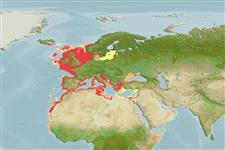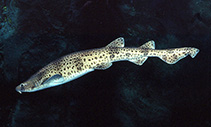Scyliorhinus stellaris (Linnaeus, 1758)
Nursehound
Add your observation in Fish Watcher
| Native range | All suitable habitat | Point map | Year 2050 |

|
| This map was computer-generated and has not yet been reviewed. |
| Scyliorhinus stellaris AquaMaps Data sources: GBIF OBIS |
Upload your photos and videos
Pictures | Videos | Stamps, coins, misc. | Google imageScyliorhinus stellaris
Picture by Océanopolis
Pictures | Videos | Stamps, coins, misc. | Google imageScyliorhinus stellaris
Picture by Océanopolis
Portugal country information
Common names:
Gata, Pata-roxa-gata, Pata-roxa-grande
Occurrence: native
Salinity: marine
Abundance: | Ref:
Importance: | Ref:
Aquaculture: | Ref:
Regulations: | Ref:
Uses: no uses
Comments:
National Checklist: Portugal
Country Information: https://www.cia.gov/library/publications/resources/the-world-factbook/geos/po.html
National Fisheries Authority:
Occurrences: Occurrences Point map
Main Ref: Compagno, L.J.V., 1984
National Database: Portuguese Freshwater Fishes
Occurrence: native
Salinity: marine
Abundance: | Ref:
Importance: | Ref:
Aquaculture: | Ref:
Regulations: | Ref:
Uses: no uses
Comments:
National Checklist: Portugal
Country Information: https://www.cia.gov/library/publications/resources/the-world-factbook/geos/po.html
National Fisheries Authority:
Occurrences: Occurrences Point map
Main Ref: Compagno, L.J.V., 1984
National Database: Portuguese Freshwater Fishes
Common names from other countries
Classification / Names ຊື່ສາມັນ | ຄຳສັບຄ້າຍຄືກັນ | Catalog of Fishes(ຕະກຸນ, ຊະນິດ) | ITIS | CoL | WoRMS | Cloffa
ກຸ່ມປາກະດູກອ່ອນ (ເຊັ່ນ: ປາສະຫລາມ, ປາຜາໄລ) (sharks and rays) > Carcharhiniformes (Ground sharks) > Scyliorhinidae (Cat sharks) > Scyliorhininae
Etymology: Scyliorhinus: skylion, Greek for dogfish or small shark; rhinus, from rhine (Gr.), rasp, alluding to a shark’s jagged, rasp-like skin (See ETYFish); stellaris: Latin for starry or of the stars, referring to many large and small black and white spots on body (See ETYFish).
More on author: Linnaeus.
Etymology: Scyliorhinus: skylion, Greek for dogfish or small shark; rhinus, from rhine (Gr.), rasp, alluding to a shark’s jagged, rasp-like skin (See ETYFish); stellaris: Latin for starry or of the stars, referring to many large and small black and white spots on body (See ETYFish).
More on author: Linnaeus.
Environment: milieu / climate zone / depth range / distribution range ນິເວດວິທະຍາ
ສັດທະເລ ກ່ຽວກັນຫີນ; ລະດັບຄວາມເລິກ 1 - 400 m (Ref. 27000), usually 20 - 63 m (Ref. 244). Subtropical; 63°N - 12°N, 19°W - 37°E
ການແຜ່ກະຈາຍ ປະເທດ | ເຂດ FAO | ລະບົບນິເວດ | ການປະກົດຕົວ | Point map | ການແນະນຳ | Faunafri
Northeast Atlantic: southern Scandinavia to Mediterranean, Morocco, Mauritania to Senegal (Ref. 125614). Records further south in the Atlantic, to Gulf of Guinea and Congo River mouth may be misidentifications of Scyliorhinus cervigoni (Ref. 127434).
Length at first maturity / ຂະໜາດ / ນ້ຳໜັກ / Age
Maturity: Lm 78.0, range 77 - 79 cm
Max length : 170 cm TL ຕົວຜູ້/ບໍ່ມີເພດ; (Ref. 26999); common length : 125 cm TL ຕົວຜູ້/ບໍ່ມີເພດ; (Ref. 244); ອາຍຸສູງສຸດທີ່ເຄຍລາຍງານມາ: 19 ປີ (Ref. 72467)
Max length : 170 cm TL ຕົວຜູ້/ບໍ່ມີເພດ; (Ref. 26999); common length : 125 cm TL ຕົວຜູ້/ບໍ່ມີເພດ; (Ref. 244); ອາຍຸສູງສຸດທີ່ເຄຍລາຍງານມາ: 19 ປີ (Ref. 72467)
Short description ຕົວທີ່ໃຊ້ໃນການຈຳແນກຊະນິດ | ສະລີລະວິທະຍາ | ການວັດແທກຮູບຮ່າງລັກສະນະພາຍນອກຂອງດິນ,ສັດ,ປາ…
ຄີ (ໜາມ)ແຂງຢູ່ຫຼັງປາ (ທັງໝົດ) : 0; ຄີ(ໜາມ) ແຂງຢູ່ຄີກົ້ນປາ
ກຸ່ມປາກະດູກແຂງ
ຄວາມຖີ່ຂອງກຸ່ມຖ່າຍທອດພັນ
ປາທີ່ມີການເຄື່ອນຍ້າຍຈາກທະເລໄປຫານ້ຳຈືດ ແລະນ້ຳຈືດຫາທະເລ
ປາທີ່ມີການເຄື່ອນຍ້າຍຈາກທະເລແລະໄປໄຂ່ຢູ່ນ້ຳຈືດ
ຄີກົ້ນຂອງປາ
ສັດທີ່ມີກະດູກສັນຫັຼງ
ການຖ່າຍທອດທາງກຳມະພັນຈາກພໍ່ແມ່ຫາລູກ: 0. A large, fairly stocky, catshark with large and small black spots and sometimes white spots covering dorsal surface, saddle markings obsolete, small anterior nasal flaps that do not reach the mouth, no nasoral grooves, labial furrows on lower jaw only, second dorsal fin much smaller than first (Ref. 244)
A common inshore and offshore shark found on the continental shelf over rough, even rocky or coralline ground, and algal-covered bottoms. Found at depths of 1 or 2 m to at least 125 m. Feed on bottom-living invertebrates such as mollusks and crustaceans and on demersal fishes (e.g. sharks, S. canicula). Oviparous (Ref. 50449). Utilized fresh and dried salted for human consumption, and processed into fishmeal. May attain 170 cm (Ref. 27000).
Life cycle and mating behavior ການຈະເລີນເຕັມໄວ | ການສືບພັນ | ການວາງໄຂ່ | ໄຂ່ | ຄວາມດົກຂອງໄຂ່ປາ | ຕົວອ່ອນ
Oviparous, with a single egg per oviduct (Ref. 244). Embryos feed solely on yolk (Ref. 50449). Size at hatching about 16 cm (Ref. 244).
Main reference
Upload your references | ເອກະສານອ້າງອີງ | ຜູ້ປະສານງານ : Compagno, Leonard J.V. | ຜູ້ຮ່ວມມື
Compagno, L.J.V., 1984. FAO Species Catalogue. Vol. 4. Sharks of the world. An annotated and illustrated catalogue of shark species known to date. Part 2 - Carcharhiniformes. FAO Fish. Synop. 125(4/2):251-655. Rome: FAO. (Ref. 244)
IUCN Red List Status (Ref. 130435: Version 2024-2)
ອ່ອນແອ, ເບີ່ງບັນຊີແດງຂອງ IUC (VU) (A2bd); Date assessed: 31 August 2020
Threat to humans
Harmless
Human uses
ການປະມົງ: ທີ່ເປັນການຄ້າໜ້ອຍ; ຕູ້ປາ: ບ່ອນວາງສະແດງສັນນ້ຳຂອງລັດ
FAO(ການປະມົງ: ຜົນຜະລິດ; publication : search) | FishSource | ທະເລອ້ອມຂ້າງພວກເຮົາ
ຂໍ້ມູນຕື່ມອີກ
Population dynamics
ຕົວວັດແທກການເຕີບໃຫຍ່
Max. ages / sizes
Length-weight rel.
Length-length rel.
Length-frequencies
Mass conversion
ການທົດແທນທີ່
ຄວາມອຸດົມສົມບູນ
ຕົວວັດແທກການເຕີບໃຫຍ່
Max. ages / sizes
Length-weight rel.
Length-length rel.
Length-frequencies
Mass conversion
ການທົດແທນທີ່
ຄວາມອຸດົມສົມບູນ
Life cycle
ການສືບພັນ
ການຈະເລີນເຕັມໄວ
ຄວາມດົກຂອງໄຂ່ປາ
ການວາງໄຂ່
Spawning aggregations
ໄຂ່
Egg development
ຕົວອ່ອນ
ການປ່ຽນແປງຂອງຕົວອ່ອນ
ການສືບພັນ
ການຈະເລີນເຕັມໄວ
ຄວາມດົກຂອງໄຂ່ປາ
ການວາງໄຂ່
Spawning aggregations
ໄຂ່
Egg development
ຕົວອ່ອນ
ການປ່ຽນແປງຂອງຕົວອ່ອນ
Physiology
Body composition
Nutrients
ການບໍລິໂພກອົກຊີເຈນ
ປະເພດການລອຍ
ຄວາມໄວໃນການລອຍ
Visual pigments
Fish sound
Diseases & Parasites
Toxicity (LC50s)
Body composition
Nutrients
ການບໍລິໂພກອົກຊີເຈນ
ປະເພດການລອຍ
ຄວາມໄວໃນການລອຍ
Visual pigments
Fish sound
Diseases & Parasites
Toxicity (LC50s)
ເຄື່ອງມື
Bio-Quiz | E-book | ຄູ່ມືພາກສະໜາມ | ຕົວທີ່ໃຊ້ໃນການຈຳແນກຊະນິດ | ຄວາມຖີ່ຂອງຄວາມຍາວປາ | ເຄື່ອງມືຂອງຊີວະປະຫວັດທາງດ້ານຊີວິດ | ຈຸດໃດໜຶ່ງທີ່ສະແດງອອກໃນແຜນທີ່ (ພ້ອມທັງສະແດງຂໍ້ມູນເພີ້ນເຕີມ) | Classification Tree
| Catch-MSY |
Special reports
Download XML
ແຫຼ່ງອີນເຕີເນັດ
Aquatic Commons | BHL | Cloffa | Websites from users | Check FishWatcher | CISTI | Catalog of Fishes(ຕະກຸນ, ຊະນິດ) | DiscoverLife | DORIS | ECOTOX | Faunafri | Fishtrace | GenBank(genome, nucleotide) | GloBI | GOBASE | | Google Books | Google Scholar | Google | IGFA World Record | MitoFish | ຖານຂໍ້ມູນແຫ່ງຊາດ | Otolith Atlas of Taiwan Fishes | ບ່ອນວາງສະແດງສັນນ້ຳຂອງລັດ | PubMed | Reef Life Survey | Scirus | SeaLifeBase | ແຜນທີ່ສະແດງກິ່ງງ່າຂອງເຊື້ອຕະກຸນປາ, ສັດ ຈາກບັນພະບູລຸດຈົນເຖິງຫລານ | Wikipedia(Go, ຊອກຫາ) | World Records Freshwater Fishing | ການບັນທຶກດ້ານສັດວິທະຍາ
Estimates based on models
Preferred temperature (Ref. 115969): 7.8 - 19.5, mean 10.9 (based on 836 cells).
Phylogenetic diversity index (Ref. 82804): PD50 = 0.5000 [Uniqueness, from 0.5 = low to 2.0 = high].
Bayesian length-weight: a=0.00178 (0.00137 - 0.00231), b=3.19 (3.12 - 3.26), in cm Total Length, based on LWR estimates for this species (Ref. 93245).
ຊັ້ນເຂດຮ້ອນ (Ref. 69278): 4.0 ±0.3 se; based on diet studies.
ຄວາມຢືດຢຸ່ນ (Ref. 120179): ຕຳ່, ປະຊາກອນຕຳ່ສຸດທີ່ໃຊ້ເວລາສອງເທົ່າ 4.5 - 14 ປີ (Fec assumed to be <100).
Fishing Vulnerability (Ref. 59153): Very high vulnerability (90 of 100).
Climate Vulnerability (Ref. 125649): Moderate vulnerability (38 of 100).




